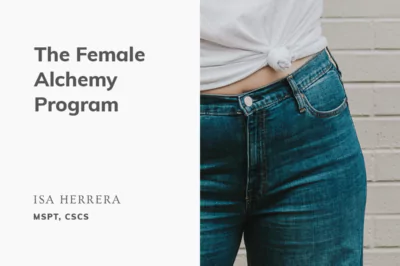Table of Contents[Hide][Show]
30 million women in the United States are suffering from pelvic floor disorders. Which means that 30 million women are suffering from debilitating and embarrassing symptoms such as urine leaking, painful sex, weak or non-existent orgasms and pelvic organ prolapse. (1-3)
This is the female health epidemic that no one is talking about and many women are suffering alone and in silence. It doesn’t have to be this way!
the realities of pelvic discomfort
Women are typically either under-treated, misdiagnosed or are told by their doctors that their only options for their “female conditions” are medications, injections into their vaginal walls or gynecological surgeries (2, 3).
Other women who suffer pelvic and bladder symptoms have been told ”the pain is in your head” or you have a “small bladder” or “relax go home and have a glass of wine and use more lube”. Female pelvic floor conditions are physical conditions they are not emotional, psychological or sexual disorders.
What’s even more alarming to me is that many female pelvic floor conditions can be healed with noninvasive natural, holistic therapies and medications are rarely needed. (4,5)
how does this happen?
I personally know what happens when a women enters the system for vaginal and pelvic issues. After the birth of my child I suffered from what I call the new “mom trifecta”, I had pain with sex, urine leaking and pelvic organ prolapse ( when your organs are not held in place by your pelvic floor muscles.)
The nurses and doctors all told me what I was experiencing was normal. The pain with sex “normal”. The urine leaking when I carried my baby “normal”. The ache and pressure in my pelvis “normal”. Maybe it was my female intuition, but I knew it wasn’t normal. So I went on a quest to heal myself.
at the bottom of all these issues…
At the bottom of all my symptoms was a dysfunctional pelvic floor. 1 out of 4 woman has one. In actuality, 18% of all gynecological laparoscopic surgeries are performed to determine the cause of pelvic pain and up to 15% of women of all women go to their doctors because of pelvic and bladder issues.x
So women are doing their best to find answers for their female problems, but the medical industry is falling short.
how the pelvic floor is being treated
Doctors are rarely taught about the pelvic floor in medical school, so they often lack the education and expertise to help these women naturally. They resort to what they know, pills, surgeries and injections. (6,7) Most of the pelvic surgeries in my opinion are unnecessary. Even the most astute doctors overlook the real culprit of women’s pelvic pain, leaking, prolapse and abdominal pain… “the pelvic floor muscles.”
After personally doing over 14,704 pelvic healings in my center, I see women who’ve received experimental drugs, Botox injections to their vaginal walls, and mesh surgeries that failed. Frankly, the side effects of these drugs and surgeries are many times worse than the symptoms the women were originally feeling. (8,9)
Guess what? You can heal your “lady parts” and bladder naturally. Read on, and I will show you how.
The Pelvic Floor and Why Is It Important For Optimal For Female Health
Our pelvic floor muscles AKA vaginal muscles are highly innervated, vascularized, and complex, and are susceptible to injuries. The pelvic floor muscles are involved in what I call the 5 functions of life. They support our organs, close off our urinary sphincters, enhance sexual function, stabilize our hips and spine and act as a sump pump for the pelvis.
The pelvic floor muscles are also the deep connectors to the upper and lower extremities and when there’s an issue with them, such as scarring from births, episiotomies, spasms, trigger points or they are too weak or too tight, they can contribute to symptoms such as urinary and fecal incontinence, pain with sex, pelvic discomfort and low to non-existent orgasms.(10)
the truth about your pelvic floor
Research has shown that very few doctors, during routine gynecological exams, perform a digital exam of the pelvic floor muscles, the area where the women are experiencing most of their pain and symptoms. (11) Heck I’ve never had a doctor examine my pelvic floor or even speak to me about it. Have you?
Here’s the truth you should know – your pelvic floor muscles can be healed through integrative and holistic practices that include massages, exercises, yoga, and meditation and mindfulness training all which can be incorporated into a self care program.(12,13)
Natural Therapies for the pelvic floor
As a matter of fact, The Center For Disease Control and National Institutes of Health have recommend natural therapies such as pelvic floor muscle training as the first line of defense in resolving symptoms related to leaking, pelvic organ prolapse and pelvic pain.(14,15) As a woman who suffered from pelvic pain and leaking after the birth of my daughter, and as a woman whom the medical community failed, I knew I had to change the conversation around pelvic healing.
I scoured the earth, educated myself and read hundreds of research papers and books. I had to go deep into my own pelvic floor healing to find natural ways to heal and cure myself from my own debilitating condition…
natural works!
…You might be thinking how did she heal her pelvis, bladder naturally and without stepping into a doctor office? I did it through natural and integrative therapies such as pelvic massages, exercises, breath work, yoga, meditation, bodywork, and mindfulness.
We all know the value of eastern medicine and also know that traditional physical therapy works for many ailments. These therapies such as yoga, mindfulness, massage and acupuncture can also be applied to lady parts with tremendous success.(16)
plus, these remedies are DIY
The great news is that with the proper guidance you can learn how to do the massages, exercises and techniques on your own and conquer your pelvic condition naturally, and become the most vibrant, symptom and pain-free version of yourself.
I have created a master class where I teach my best tips, massages and exercises that will put you back in the driver’s seat of your pelvic, sexual and bladder health.
Take the Class!
Sign up for my complimentary master class “Female Pelvic Healing: 5 Steps to Healing Leaking, Intimacy Pain and Prolapse Naturally Without Going to the Doctor. Learn tips and tools you won’t find anywhere else that will help you to feel whole again and in control of your pelvic, sexual and bladder health.
It’s simply your birthright to understand your divine female anatomy. And it’s time you claimed it.
Sign up here!
About the Author
Isa Herrera, MSPT, CSCS is a New York City-based holistic women’s pelvic floor specialist, author of 5 books on pelvic health, including the 2017 international best seller Female Pelvic Alchemy and the groundbreaking self-help book, Ending Female Pain, A Woman’s Manual.
She has dedicated her career to advancing awareness of pelvic floor conditions so that more women can find relief from this silent epidemic that affects over 30 million women in the US alone. Ms. Herrera holds a BA in Psychology and Biology from Fordham University and also a Masters in Physical Therapy from Hunter College. For more info, go to http://www.PelvicPainRelief.com
References:
1) Harlow BL, Kunitz CG, Nguyen RHN, et al. Prevalence of symptoms consistent with a diagnosis of vulvodynia: population-based estimates from 2 geographic regions. Am J Obstet Gynecol. 2014;210:40.
2) Mathias SD1, Kuppermann M, Liberman RF, et al. Chronic pelvic pain: prevalence, health-related quality of life, and economic correlates. Obstet Gynecol. 1996;87(3):321–327.
3) Reed BD, Harlow SD, Sen A, et al. Prevalence and demographic characteristics of vulvodynia in a population-based sample. Am J Obstet Gynecol. 2012;206:170.1–9.
4) Arnold LD, Bachmann GA, Rosen R, et al. Vulvodynia: characteristics and associations with comorbidities and quality of life. Obstet Gynecol. 2006;107:617–624.
5) Nickel JC, Tripp D, Teal V, et al. Sexual function is a determinant of poor quality of life for women with treatment refractory interstitial cystitis. J Urol. 2007;177(5):1832–1836.
6) Paulozzi LJ, Mack KA, Hockenberry JM. Vital signs: variation among states in prescribing of opioid pain relievers and benzodiazepines—United States, 2012. MMWR Morb Mortal Wkly Rep 2014;63:563–8. PubMed
7) Paulson JD, Delgado M. Chronic pelvic pain: The occurrence of interstitial cystitis in a gynecological population. Journal of the Society of Laparoendoscopic Surgeons. 2005;9(4):426–430.Retrieved from http://www.ncbi.nlm.nih.gov/pmc/articles/PMC3015651/?tool=pubmed.
8) Gerrits MM, van Oppen P, van Marijk HW,et al. Pain and the onset of depressive and anxiety disorders. Pain. 2014;155:53–59
9) Pacik PT, Understanding and Treating Vaginismus: A Multiimodal Approach. Int Urogynecol J. 2014 Dec;25(12):1613-20. doi: 10.1007/s00192-014-2421-y. Epub 2014 Jun 4.
10) Gray’s Anatomy: The Anatomical Basis of Clinical Practice, 41e by Susan Standring PhD
11) Kavvadias T, Baessler K, Schuessler B. Pelvic pain in urogynaecology. Part I: evaluation, definitions and diagnoses. International Urogynecology Journal. 2011;22(4):385–393. doi: 10.1007/s00192-010-1218-x. [PubMed]
12) Crisp CD, Hastings-Tolsma M, Jonscher KR.Mindfulness-based stress reduction for military women with chronic pelvic pain: a feasibility study.Mil Med. 2016;181(9):982-989. doi:10.7205/MILMED-D-15-00354
13) van der Kolk BA, Stone L, West J, et al. Yoga as an adjunctive treatment for posttraumatic stress disorder: a randomized controlled trial.J Clin Psychiatry. 2014; 75(6):e559-65. doi:10.4088/JCP.13m08561
14) CDC Guideline for Prescribing Opioids for Chronic Pain — United States, 2016 Recommendations and Reports / March 18, 2016 / 65(1);1–49
15) NIH State-of-the-Science Conference: Prevention of Fecal and Urinary Incontinence in Adults December 10-12, 2007 Bethesda, Maryland
16) Goldfinger C, Pukall CF, Thibault-Gagnon S, et al. Effectiveness of cognitive-behavioral therapy and physical therapy for provoked vestibulodynia: a randomized pilot study.J Sex Med. 2016; 13(1):88-94. doi:10.1016/j.jsxm.2015.12.003



Leave a Reply